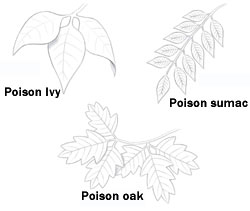Poison ivy is a green plant that grows low to the ground. It always appears as a shiny cluster of three reddish-green, teardrop-shaped leaves. Poison oak looks a lot like grape ivy. It is a vine with clusters of three leaves, sometimes three clusters to a branch; all of the leaves are wavy-edged. Poison sumac is usually found on trees in forests, but it can also grow on a bush. Its leaves are pointed like a palm fan and grow in pairs, except at the tip where there is always one leaf.
Treating Poison Ivy and Its “Cousins”
Symptoms of the irritation caused by the three poison plants include red rashes (sometimes accompanied by small blisters), itching, possible headache and fever, and a blistering rash. Coming into contact with poison ivy, poison oak, or poison sumac is rarely fatal. In fact, it does not require professional help—unless a person suffers a severe allergic reaction. However, it’s important to treat symptoms from poison ivy and its cousins because it can spread to other parts of the body. It can even spread from clothes to skin. Follow these steps:
